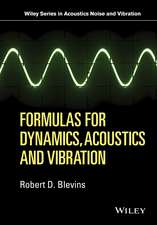Dissipative Structures and Weak Turbulence
Paul Mannevilleen Limba Engleză Hardback – 20 iun 1990
Preț: 828.45 lei
Preț vechi: 1134.86 lei
-27% Nou
Puncte Express: 1243
Preț estimativ în valută:
158.53€ • 165.93$ • 131.94£
158.53€ • 165.93$ • 131.94£
Carte tipărită la comandă
Livrare economică 01-15 aprilie
Preluare comenzi: 021 569.72.76
Specificații
ISBN-13: 9780124692602
ISBN-10: 0124692605
Pagini: 448
Ilustrații: 1
Dimensiuni: 152 x 229 x 42 mm
Greutate: 0.89 kg
Editura: ELSEVIER SCIENCE
ISBN-10: 0124692605
Pagini: 448
Ilustrații: 1
Dimensiuni: 152 x 229 x 42 mm
Greutate: 0.89 kg
Editura: ELSEVIER SCIENCE
Cuprins
Foreword
Chapter 1. Outlook
1. Dissipative Structures
2. Transition to Temporal Chaos
3. Spatio-Temporal Chaos and Weak Turbulence
4. Bibliographical Notes
Chapter 2. Evolution and Stability, Basic Concepts
1. General Framework
1.1. Discrete Versus Continuous Systems
1.2. Autonomous Versus Time-Dependent Systems
1.3. Deterministic Evolution
1.4. Perturbations and Stability
2. Global Stability
2.1. General Viewpoint and Definitions
2.2. Energy Method
2.3. Different Concepts of Stability
3· Normal Modes, Linear and Nonlinear Dynamics
3.1. Normal Mode Analysis
3.2. Weakly Nonlinear Dynamics
4. Qualitative Dynamics
4.1. Elements for a Phase Portrait
4.2. Absorbing Zones and Limit Sets
4.3. Limit Sets and Attractors
4.4. Hyperbolicity, Structural Stability, and Bifurcations
4.5. About More General Attractors
5. Bibliographical Notes
Chapter 3. Instability Mechanisms
1. Rayleigh-Bénard Convection
1.1. Qualitative Analysis
1.2. Simplified Model
1.3. Normal Mode Analysis
1.4. Linear Dynamics of Unstable Modes
2. Convection in Binary Mixtures
2.1. Stationary Mode
2.2. Oscillatory Mode
3. Thermal Convection in Nematic Liquid Crystals
4. Electrohydrodynamic Instabilities in Nematics
4.1. Carr-Helfrich Mechanism
4.2. Two Instability Regimes
5. Taylor-Couette instability
5.1. Centrifugal Instabilities
5.2. Rayleigh Instability Mechanism
5.3. One-Dimensional Model
6. Bénard-Marangoni Convection
6.1. Mechanism and Simplified Model
6.2. Marangoni Versus Buoyancy-Driven Convection
7. Bibliographical Notes
Chapter 4. Thermal Convection
1. Boussinesq Equations and Boundary Conditions
1.1. Evolution Equations
1.2. Boundary Conditions
2. Normal Mode Analysis
2.1. Stress-Free Solution, Rayleigh (1916)
2.2. No-Slip Solution, Pellew and Southwell (1940)
2.3. Vicinity of the Threshold (Linear Stage)
2.4. Approximate Determination of Threshold Curves
2.5. Treatment of the Vertical Vorticity
3. Phenomenology of Nonlinear Convection
3.1. Introduction
3.2. Universal Secondary Modes
3.3. Specific Secondary Instabilities
4. Phenomenology of the Transition to Turbulence
4.1. "Old" Results
4.2. "Recent" Results, Concrete Examples
4.3. Concluding Remarks
5. Bibliographical Notes
Chapter 5· Low-Dimensional Dynamical Systems
1. Dimension Reduction: A Case Study
1.1. The Model and Its Normal Modes
1.2. Elimination of Slaved Modes: Heuristic Approach
2. Center Manifold and Normal Forms
2.1. Perturbative Approach to the Center Manifold
2.2. Normal Forms of Dynamical Equations
2.3. Normal Forms and Symmetries
2.4. Slightly Off the Critical Point
3. Dynamics and Bifurcations in One Dimension
3.1. General Dynamics
3.2. Normal/Inverse Bifurcations
3.3. Conditional Stability, Hysteresis, and Turning Points
3.4. Transcritical Bifurcations
3.5. Imperfect Bifurcations
3.6. Mathematical Context: Unfolding of Singularities
4. Introduction to Higher Dimensional Problems
5. Dynamics and Bifurcations in Two Dimensions
5.1. Linear Dynamics
5.2. Nonlinear Dynamics, an Example: The Pendulum
5.3. General Dynamics in Two Dimensions
5.4. Bifurcations in Two Dimensions
6. Conclusion
7. Bibliographical Notes
Chapter 6. Beyond Periodic Behavior
1. Poincaré Maps
1.1. Surface of Section and First Return Map
1.2. Application to the Lorenz Model
2. Stability of a Limit Cycle
3. Bifurcations of a Limit Cycle
3.1. Normal Form in the Complex Case
3.2. Hopf Bifurcation for Maps
3.3. Bifurcations at Strong Resonances 1/1 and 1/2
4. Nature of Turbulence and Transition Scenarios
5. Sub-Harmonic Route to Turbulence
5.1. The Modeling Issue
5.2. The Sub-Harmonic Cascade
5.3. Universality and Renormalization
5.4. Beyond the Accumulation Point
5.5. Concluding Remark
6. Temporal Intermittency
6.1. Modeling of Intermittent Behavior
6.2. Type I Intermittency
6.3. Type III Intermittency
6.4. Type II Intermittency
7. Quasi-Periodicity
7.1. Introduction to the Locking Phenomenon
7.2. The Winding Number and the Structure of Lockings
7.3. The Breakdown of a Two-Torus
7.4. Ruelle-Takens Scenario and n-Periodicity
8. Beyond "Classical" Scenarios
9. Bibliographical Notes
Chapter 7. Characterization of Temporal Chaos
1. Divergence of Trajectories and Lyapunov Exponents
1.1. One-Dimensional Iterations
1.2. Generalization to d-Dimensional Maps
1.3. Generalization to Differential Systems
1.4. Lyapunov Signature of Temporal Behavior
2. Probabilistic Approach
2.1. Entropy
2.2. Invariant Measures
2.3. Invariant Measures for One-Dimensional Maps
2.4. Natural Measures
3. Chaos and Dimensions
3.1. Introduction
3.2. Fractal Geometry
3.3. Probabilistic Viewpoint
3.4. Dimensions and Lyapunov Exponents
4. Experimental Approach
4.1. The Method of Time Delays
4.2. Embedding
4.3. Practical Problems
4.4. Dimension Estimates
4.5. Determination of Lyapunov Exponents
4.6. Final Remark
5. Bibliographical Notes
Chapter 8. Basics of Pattern Formation in Weakly Confined Systems
1. Instabilities, Confinement, and Aspect Ratios
2. Pattern Formation
2.1. Modeling of Weakly Confined Systems
2.2. Pattern Formation in Two Dimensions
3. Uniform Nonlinear Solutions
3.1. General Setting
3.2. Steady Solutions of Two-Dimensional Models
3.3. Rayleigh-Bénard Convection
4. Modulated Structures
4.1. Systematic Expansion
4.2. Roll Modulations in a Rotationally Invariant System
4.3. Extension to Two-Dimensional Patterns
4.4. Short-Term Stability and Early Nonlinear Selection
4.5. Phenomenological Extension: The Example of Waves
5. Bibliographical Notes
Chapter 9. Applications of the Envelope Formalism
1. Phase Winding Solutions
2. Long Wavelength Instabilities
2.1. General Formulation
2.2. Longitudinal Perturbations and Eckhaus Instability
2.3. Transverse Perturbations and Zigzag Instability
2.4. Stability of Waves
3. Lateral Boundary Effects
3.1. Rolls Parallel to a Lateral Wall
3.2. Rolls Perpendicular to a Lateral Wall
4. Structural Defects
4.1. Grain Boundaries
4.2. Dislocations
5. Pattern Selection at Lowest Order
6. Bibliographical Notes
Chapter 10. Dynamics of Textures and Turbulence
1. Phase Diffusion in Steady Roll Patterns
1.1. Phase Diffusion Formalism
1.2. Phase Instabilities
1.3. Rotationally Invariant Formulation of Phase Dynamics
2. Nonlinear Selection and Weak Turbulence
2.1. Nonlinear Wavelength Selection Criteria
2.2. Drift Flows and the Transition to Weak Turbulence
3. Transition to Turbulence in Oscillating Patterns
4. Spatio-Temporal Intermittency
4.1. Introduction
4.2. A Case Study: The Modified Swift-Hohenberg Model
4.3. Towards a Theory
5. Hydrodynamics and Turbulence
5.1. Introduction
5.2. Advection and Absolute/Convective Instabilities
5.3. Homogeneous, Isotropic, Developed Turbulence
6. Bibliographical Notes
Appendix 1. Macroscopic Dynamics
1. General Fluid Systems
1.1. Densities and General Balance Equations
1.2. Fluid Particles and the Continuity of Matter
1.3. Fundamental Equation of Dynamics
2. Thermohydrodynamics
2.1. Energy Continuity and First Principle
2.2. Entropy Source and Second Principle
2.3. Constitutive Equations
2.4. Summary of the Equations for a Simple Fluid
2.5. Passive Mixtures
2.6. Fluid Interfaces
3· Nematic Liquid Crystals
3.1. The Nematic Phase
3.2. Elasticity
3.3. Statics
3.4. Dynamics
3.5. Viscometry
4. Bibliographical Notes
Appendix 2. Differential Calculus
1. Initial Value Problems
1.1. Introduction
1.2. Linear Maps, Matrices, and Change of Bases
1.3. Eigenvalues and Invariant Subspaces
1.4. Application to Linear Initial Value Problems
2. Boundary Value Problems
2.1. Scalar Products and Adjoint Problems
2.2. Adjointness for Boundary Value Problems
3. Differential Equations with Delay
4. Bibliographical Notes
Appendix 3. Numerical Simulations
1. Introduction
2. Finite Differences for Time Stepping
3· Treatment of Partial Differential Equations
3.1. Finite Difference Methods
3.2. Spectral Methods
4. Bibliographical Notes
Subject Index




















